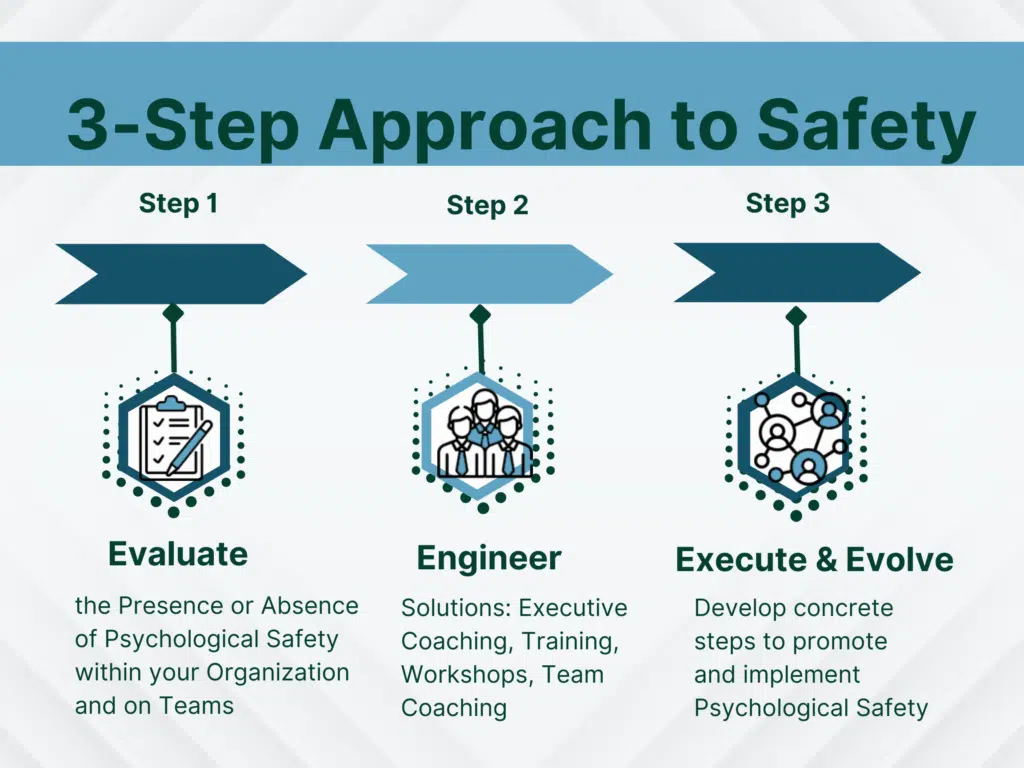3-Step Approach for Building Psychological Safety and Trust
The concept of psychological safety and trust are integral to building high-performing teams. Creating psychological safety is a continuous process requiring buy-in from leadership and human resources. In this blog, you will learn what the 3-step approach is and how to anchor safety and trust by evaluating, engineering, and executing a process of psychological safety.
What is Psychological Safety?
Psychological safety is a shared belief among teams and their members that they can take interpersonal risks, share their concerns candidly, or voice their opinions and ideas without fearing being judged, mocked, ridiculed, or punished by others in a team.
It allows people to experiment, make mistakes, innovate, and aspire to a better version of themselves. Psychological safety also builds a safe working environment for a high-performing and resilient workplace.
What is the Fearless Navigation 3-Step Approach?
Step 1: Evaluate the Presence or Absence of Psychological Safety within your Organization and on Teams:
The first step in creating a psychologically safe environment is to assess the current state of psychological safety within your teams and inside your organization.
Here are some ways to evaluate your environment:
- Administer surveys to assess the level of psychological safety in your organization.
- Educate employees and individuals on what psychological safety is and what it is not.
- Define what psychological safety means to your organization and your teams.
- Create focus groups to discuss the measures implemented.
- Gather feedback from team members about their perceptions of psychological safety.
- Analyze data collected via surveys and feedback.
- Identify areas of strength.
- Identify areas of improvement.
- Communicate and share results with the team.
- Develop an action plan to foster a psychologically safe environment successfully.
Step 2: Engineer Solutions: Executive Coaching, Training, Workshops, Team Coaching
- Conduct training programs for employees, managers, and stakeholders.
- Host workshops relating to psychological safety.
- Offer team coaching to facilitate discussions, establish goals, and develop team-building exercises.
- Choose a certified coach and facilitator with expertise in psychological safety. Our firm, Rock the Boat, can help!
- Make sure all team members have access to learning and development, irrespective of their organizational role.
- Effectively communicate the purpose and benefits of the rollout.
Step 3: Execute and Evolve
- Develop concrete steps to promote psychological safety.
- Set a timeline for implementation.
- Monitor and keep track of progress.
- Regularly communicate with the team regarding the progress of the initiative.
- Celebrate small wins along the way to reinforce and encourage participation.
- Evolve and grow together by improving conditions, practices, and experiences.
What are the Benefits and Effects of Building Psychological Safety?
For Individuals
Creating psychological safety leads to fearlessness, security, trust, bravery, confidence, contentment, happiness, and a sense of being acknowledged, valued, and included among individuals in a team or within an organization.
For Teams
Psychological safety fosters learning, innovation, critical thought, creativity, productivity, and collaboration for teams to grow as a unit.
For Organizations
Organizations prioritizing psychological safety build high-performing individuals and teams and retain talent that helps organizations stay on top of the market and ahead of the competition.
For Society
Happy employees who do meaningful work are more likely to contribute to the greater good and benefit of society.
Conclusion:
The level of psychological safety determines the culture of an organization. Teams with a good level of psychological safety are proven to be high-performing with better communication and collaboration.
The Fearless Navigation 3-step approach of Evaluating, Engineering, and Executing can help organizations confidently navigate this path. By committing to continuous evolution and improvement, teams can cultivate an environment of trust and psychological safety that enables individuals to perform at their best.
Recent Posts:
Recommended Reading:
A Guide to Building Psychological Safety on Your Team by Rakshitha Arni Ravishankar
High Performing Teams Need Psychological Safety: Here’s How to Create It by Laura Delizonna
Meet Jodie, your Culture & Transformation Captain. With over twenty years helping people change, facilitating team discussions, building cultures, designing, implementing and teaching classes, your organization is in good hands.





